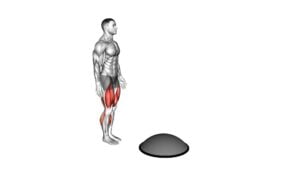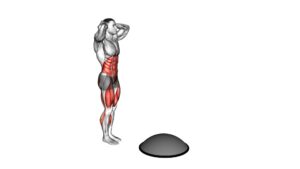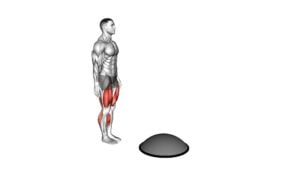High Knee Lunge on Bosu Ball – Video Exercise Guide & Tips

Looking to switch up your workout routine? Try the high knee lunge on a Bosu ball! This exercise targets your lower body and improves balance and stability.
Watch This Exercise Video
In this video exercise guide, we'll show you proper form and technique, along with modifications and progressions to challenge yourself. Avoid common mistakes and get tips for a safe and effective workout.
Get ready to level up your fitness game with this challenging and dynamic exercise!
Key Takeaways
- High Knee Lunge on Bosu Ball targets multiple muscle groups and strengthens the lower body.
- Engaging core muscles during the exercise provides added benefits and helps with stability.
- Proper body alignment, breathing, and core engagement are crucial for effective and safe execution of the exercise.
- It is important to avoid common mistakes, modify the exercise according to fitness level, and progress gradually for a safe and effective workout.
Benefits of High Knee Lunge
What are the benefits of performing the High Knee Lunge on the Bosu Ball?
The High Knee Lunge is a dynamic exercise that targets multiple muscle groups, providing numerous benefits for your body. By incorporating the Bosu Ball into this exercise, you can enhance its effectiveness and challenge your balance and stability even more.
One of the main benefits of the High Knee Lunge is that it strengthens your lower body, particularly your quadriceps, hamstrings, and glutes. This exercise also engages your core muscles, helping to improve your balance and stability. Additionally, the High Knee Lunge is a great cardiovascular exercise, as it increases your heart rate and burns calories.
Furthermore, the High Knee Lunge offers variations that allow you to target different muscle groups and add variety to your workouts. For example, you can perform a forward lunge, a reverse lunge, or a lateral lunge on the Bosu Ball, targeting different angles and directions.
Incorporating the Bosu Ball into the High Knee Lunge also challenges your proprioception and improves your overall balance and coordination. This can be beneficial for athletes and individuals who want to enhance their performance in sports or daily activities.
Now that you know the benefits of the High Knee Lunge, let's move on to the equipment needed for this exercise.
Equipment Needed for the Exercise
To perform the High Knee Lunge on the Bosu Ball, you'll need a few pieces of equipment. The primary equipment you'll need is a Bosu Ball, which is a half-sphere stability training device. The Bosu Ball is designed to challenge your balance and stability during exercises. It consists of an inflated rubber dome attached to a solid platform. The dome side is used for exercises like the High Knee Lunge, where you stand on the dome and perform lunges.
In addition to the Bosu Ball, you may also want to consider using a mat for added comfort and stability. A yoga mat or exercise mat can provide cushioning for your knees and help prevent slipping during the exercise.
If you don't have access to a Bosu Ball, there are a few alternatives you can try. One option is to use a stability ball, also known as a Swiss ball or exercise ball. It can provide a similar unstable surface to challenge your balance and stability. Another alternative is to use a foam pad or balance pad. These are soft, cushioned pads that can be placed on the ground to create an unstable surface.
Proper Form and Technique
To perform the High Knee Lunge on a Bosu Ball with proper form and technique, it's important to focus on body alignment, breathing, and core engagement.
Keep your back straight, shoulders relaxed, and knees in line with your toes to maintain proper body alignment throughout the exercise.
Remember to breathe deeply and engage your core muscles to stabilize your body and maintain balance.
Avoid common mistakes like leaning forward, rounding your back, or holding your breath, as these can compromise the effectiveness and safety of the exercise.
Body Alignment During Exercise
Maintain proper body alignment during exercise by keeping your knees in line with your toes and engaging your core. Proper body alignment is crucial for a successful workout. It not only helps prevent injuries, but also enhances the effectiveness of your exercises.
Maintaining good posture is important as it helps distribute the load evenly throughout your body, reducing strain on specific muscles or joints. When your body is properly aligned, you can engage the targeted muscles more effectively, leading to better results.
Additionally, proper body alignment ensures that you're using the correct muscles for each exercise, maximizing the benefits and reducing the risk of compensatory movements. So, remember to focus on maintaining proper body alignment during your workouts to optimize your performance and achieve your fitness goals.
Breathing and Core Engagement
Are you wondering how to properly engage your core and breathe during the High Knee Lunge on Bosu Ball exercise? Proper breathing techniques and engaging the core effectively are crucial for maximizing the benefits of this exercise.
Here are four important tips to help you achieve the proper form and technique:
- Breathe deeply: Inhale deeply through your nose as you lower your body into the lunge position. Exhale fully through your mouth as you push off the Bosu Ball and lift your knee towards your chest.
- Engage your core: Before starting the exercise, engage your core by pulling your belly button towards your spine. This helps stabilize your torso and maintain proper alignment.
- Maintain a neutral spine: Throughout the exercise, keep your spine in a neutral position by avoiding excessive arching or rounding. This helps protect your back and promotes better balance.
- Focus on controlled movements: Perform the exercise with slow and controlled movements, emphasizing the engagement of your core muscles. This helps improve stability and strengthens your abdominal muscles.
Common Mistakes to Avoid
One common mistake to avoid when performing the High Knee Lunge on Bosu Ball exercise is failing to keep your knee in line with your toes, as this can put unnecessary strain on your joints. It's important to maintain proper form and technique to maximize the benefits of this exercise while minimizing the risk of injury.
Here are some common errors in high knee lunge form and how to avoid them. Firstly, avoid allowing your knee to collapse inward or outward during the lunge. Instead, focus on keeping your knee directly above your ankle.
Secondly, avoid leaning too far forward or backward, as this can disrupt your balance and compromise the effectiveness of the exercise. Instead, keep your upper body upright and engage your core muscles for stability.
Modifications and Progressions
Now let's talk about some ways to modify and progress the high knee lunge on the Bosu ball.
For beginners, you can start by performing the exercise without the Bosu ball or by using a stable surface for balance.
As you become more advanced, you can add a jump at the top of the movement or increase the speed and intensity of the exercise.
However, it's important to keep safety in mind and listen to your body to avoid overexertion or injury.
Beginner Modifications
To modify the high knee lunge on the Bosu Ball for beginners, start by using a stable surface such as the floor or a step.
Here are four variations for different fitness levels:
- Basic Lunge: Stand with your feet hip-width apart and step one foot forward into a lunge position. Lower your back knee towards the ground while keeping your front knee aligned with your ankle. Repeat on the other side.
- Elevated Lunge: Place your front foot on a step or platform, keeping your back foot on the ground. Perform the lunge as described above, focusing on maintaining proper form and balance.
- Assisted Lunge: Hold onto a sturdy surface, such as a wall or a chair, for support while performing the lunge. This will help with stability and balance.
- Partial Range Lunge: Instead of lowering your back knee all the way to the ground, only go halfway down. This modification reduces the range of motion and makes the exercise easier for beginners.
Remember to listen to your body and start with the modification that best suits your fitness level. As you become more comfortable and stronger, you can gradually progress to more challenging variations.
Advanced Progressions
Once you have mastered the beginner modifications, it's time to take your high knee lunge on the Bosu Ball to the next level with advanced progressions. These advanced modifications will challenge your balance, stability, and strength even further.
One advanced technique you can try is adding a medicine ball to your high knee lunge. Hold the medicine ball in front of you as you perform the lunge, engaging your core and upper body muscles.
Another advanced modification is to perform the high knee lunge on a wobble board instead of a Bosu Ball. The unstable surface of the wobble board will require even more control and stability.
Don't forget to always maintain proper form and listen to your body when attempting these advanced techniques.
Safety Considerations
To ensure your safety and maximize your progressions, it's important to consider modifications and progressions when performing the high knee lunge on the Bosu Ball. Here are some safety considerations to keep in mind:
- Start with a proper warm-up: Before attempting the high knee lunge on the Bosu Ball, it's crucial to warm up your muscles and joints. This will help prevent injuries and prepare your body for the exercise.
- Use a stable surface: If you're new to the high knee lunge on the Bosu Ball, it's a good idea to start on a stable surface like the floor or a mat. As you gain strength and stability, you can gradually progress to using the Bosu Ball.
- Modify the exercise: If you find the high knee lunge on the Bosu Ball too challenging or feel any discomfort, consider modifying the exercise. You can perform the exercise without the Bosu Ball or use a lower platform for added stability.
- Listen to your body: It's important to listen to your body and not push yourself beyond your limits. If you experience pain or discomfort during the exercise, stop immediately and consult with a fitness professional or healthcare provider.
Common Mistakes to Avoid
When performing the High Knee Lunge on the Bosu Ball, be mindful of avoiding these common mistakes. Proper technique is crucial to prevent injury and maximize the effectiveness of this exercise.
One common mistake isn't maintaining proper form throughout the movement. Make sure to keep your back straight, shoulders back, and chest lifted. Avoid leaning forward or rounding your back, as this can strain your lower back and decrease the effectiveness of the exercise.
Another mistake isn't engaging your core muscles. To get the most out of the High Knee Lunge, engage your core by pulling your belly button in towards your spine and activating your abdominal muscles. This will help stabilize your body and improve your balance.
It is also important to avoid rushing through the exercise. Take your time and focus on each repetition. Make sure to fully extend your leg during the lunge and bring your knee up as high as possible during the knee drive. This will engage the muscles more effectively and increase the intensity of the exercise.
Lastly, be cautious of using excessive momentum. The High Knee Lunge should be controlled and deliberate. Avoid swinging your leg or relying on momentum to complete the movement. Instead, focus on using your leg muscles to drive the movement.
Tips for a Safe and Effective Workout
Ensure a safe and effective workout by following these tips:
- Warm up properly: Before starting any workout, it's crucial to warm up your muscles and prepare your body for the upcoming physical activity. This helps increase blood flow, flexibility, and reduces the risk of injuries.
- Use proper form and technique: Correct form and technique are essential for maximizing results and preventing injuries. Pay attention to your posture, alignment, and movement patterns. If you aren't sure about the correct form, consider working with a qualified trainer or instructor.
- Listen to your body: It's important to listen to your body and avoid pushing yourself too hard. Pay attention to any discomfort or pain during your workout. If something doesn't feel right, modify the exercise or take a break. Pushing through pain can lead to injuries and setbacks.
- Gradually increase intensity: If you want to maximize your results, it's important to gradually increase the intensity of your workouts. Push yourself to challenge your body, but do it in a controlled and progressive manner. This allows your body to adapt and prevents overexertion.
Frequently Asked Questions
How Many Sets and Reps Should I Do for the High Knee Lunge on Bosu Ball Exercise?
For the high knee lunge on the Bosu ball exercise, you should start by determining your fitness level and goals. Generally, aim for 2-3 sets of 10-15 reps on each leg. Remember to rest between sets and focus on proper form.
To modify the exercise, you can perform it without the Bosu ball or decrease the range of motion.
To progress, you can add weights or increase the number of reps.
Can I Do the High Knee Lunge on Bosu Ball Exercise if I Have Knee Pain?
If you're experiencing knee pain, it's best to avoid the high knee lunge on a bosu ball exercise. Instead, consider alternatives like regular lunges or step-ups, which are less intense on the knees.
If you still want to challenge yourself with the bosu ball, try modifications like standing on the flat side instead.
Is It Recommended to Warm up Before Performing the High Knee Lunge on Bosu Ball Exercise?
To get the most out of your workout, it's important to warm up before doing high knee lunges on a Bosu ball. Warm up exercises have many benefits, like increasing blood flow and flexibility, which can help prevent injuries.
If you're a beginner, you may need to modify the exercise by starting with regular lunges on solid ground before progressing to the Bosu ball.
Always listen to your body and consult with a fitness professional if you have any concerns.
Can I Do the High Knee Lunge on Bosu Ball Exercise if I Have Limited Balance or Coordination?
If you have limited balance or coordination, it may not be recommended to do the high knee lunge on a Bosu ball exercise. It's important to prioritize safety and avoid potential falls or injuries.
However, there are balance modifications and alternative exercises you can try that still target the same muscle groups.
It's always a good idea to consult with a fitness professional for personalized guidance and recommendations based on your specific needs and abilities.
How Often Should I Incorporate the High Knee Lunge on Bosu Ball Exercise Into My Workout Routine for Optimal Results?
To achieve optimal results, it's important to incorporate the high knee lunge on the Bosu ball exercise into your workout routine at the right frequency.
This exercise can be done 2-3 times a week for beginners, gradually increasing to 4-5 times a week for more advanced individuals.
If you have limited balance or coordination, modifications can be made, such as using a stable surface or holding onto a support for assistance.
Consistency is key for seeing the best results.
Conclusion
In conclusion, the high knee lunge on the Bosu ball is a beneficial exercise that helps to strengthen the lower body and improve balance and stability.
With the right equipment and proper form, this exercise can be modified and progressed to challenge different fitness levels.
By avoiding common mistakes and following safety tips, you can ensure a safe and effective workout.
Incorporate this exercise into your routine for a well-rounded fitness regimen.

Author
Years ago, the spark of my life’s passion ignited in my mind the moment I stepped into the local gym for the first time. The inaugural bead of perspiration, the initial endeavor, the very first surge of endorphins, and a sense of pride that washed over me post-workout marked the beginning of my deep-seated interest in strength sports, fitness, and sports nutrition. This very curiosity blossomed rapidly into a profound fascination, propelling me to earn a Master’s degree in Physical Education from the Academy of Physical Education in Krakow, followed by a Sports Manager diploma from the Jagiellonian University. My journey of growth led me to gain more specialized qualifications, such as being a certified personal trainer with a focus on sports dietetics, a lifeguard, and an instructor for wellness and corrective gymnastics. Theoretical knowledge paired seamlessly with practical experience, reinforcing my belief that the transformation of individuals under my guidance was also a reflection of my personal growth. This belief holds true even today. Each day, I strive to push the boundaries and explore new realms. These realms gently elevate me to greater heights. The unique combination of passion for my field and the continuous quest for growth fuels my drive to break new ground.







